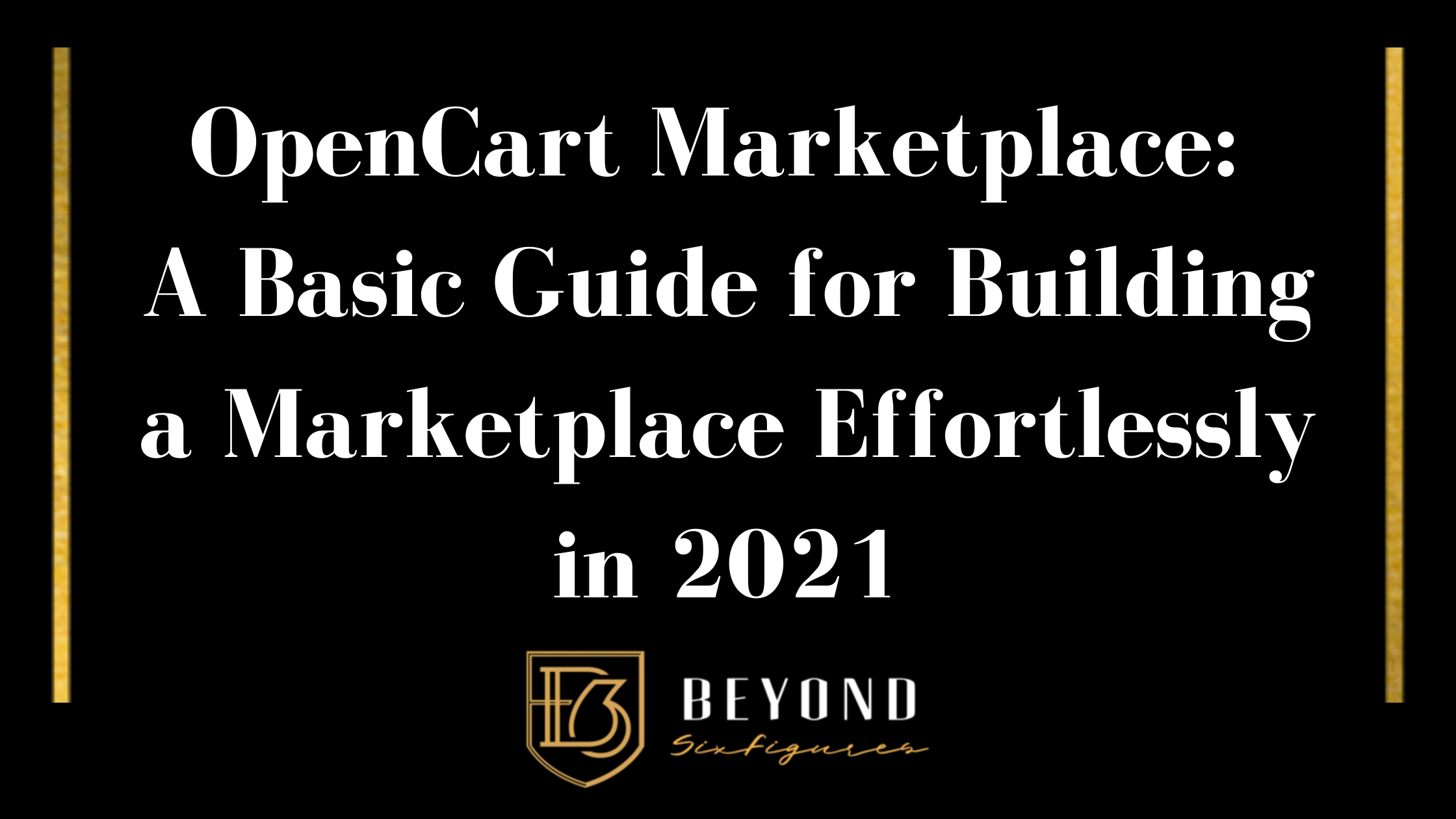OpenCart Marketplace: A Basic Guide for Building a Marketplace Effortlessly in 2021
OpenCart is an all-in-one, open-source ecommerce platform. The OpenCart Marketplace is the online marketplace built for ecommerce entrepreneurs to quickly and efficiently build their unique online store.
Looking to create an online marketplace but not sure how to start? Look no further; we have you covered.
In this article, we will dive into the specifics of OpenCart Marketplace and how you can use this tool to build on your business’s online presence.
At the end of this article, we will also give a brief comparison of OpenCart versus a few other popular ecommerce platforms so you can make the most informed opinion of what will best suit your needs.

What are OpenCart and OpenCart Marketplace?
OpenCart is a free platform to download and customize to create a unique website and online store. In a sense, it makes a blank slate from which you can build on to create a unique website for your business. This software provides powerful store management and a plethora of extensions and themes for customization.
OpenCart powers more than 300,000 eCommerce stores worldwide. As the eCommerce industry grows, this software continues to develop and change to meet its users’ needs.
Once you have downloaded and installed OpenCart, then you turn to OpenCart Marketplace to customize your website.
OpenCart Marketplace is the official online store of the OpenCart software. This online marketplace houses more than 13,000 modules and themes in the form of extensions to customize your online store.
Installing OpenCart Marketplace
Downloading OpenCart is simple and easy. The OpenCart website gives you easy-to-understand instructions and different options for downloading.
Step 1: Download OpenCart
Download OpenCart directly from the website. It’s essential to download the latest software version for the most up-to-date bug fixes and features.
Step 2: Upload Files to Your Server
Install OpenCart to your web server through a File Transfer Protocol (FTP) client. To install OpenCart, the projected web server must meet specific requirements for it to work correctly.
These requirements include PHP (at least 5.4), Curl enabled, and a database (MySQLi suggested).
Step 3: Run the Automatic Installer
By opening the OpenCart location, the software will automatically go through the steps for simple installation.
Selecting Your Host
Since OpenCart Marketplace is open-source software, this also means that it is entirely self-hosted. Some may see this as an opportunity to bring in their favorite or self-developed host server, while some may see this as a disadvantage requiring extra steps on their part.
It’s all how you look at it.
You have two initial hosting options when first downloading and installing OpenCart Marketplace – Download and host your own or set up with OpenCart’s hosting partner, A2 Hosting.
There are benefits to both sides. If you choose to download and host your own, you have the option to customize your unique hosting situation. This option is great if you already have a great working relationship with a host server or those who may have created their own. This selection is a good option for the most customization.
On the other hand, if you choose to stick with OpenCart’s hosting partner, A2 Hosting, they handle the entire uploading and setup process. Since they are partners, A2 Hosting provides hosting optimized for OpenCart websites and a reliable, high-speed hosting service.
Once you have made the decision between hosts and have fully uploaded and set up your website, it’s time to start looking at extensions to build on your store.
Adding Extensions
Extensions are what will extend your online store’s functionality. This step is where the OpenCart Marketplace comes into play. With over 13,000 extensions available, we’re sure you will find anything you need to develop a unique and customized online store.
The categories of the available extensions include Marketplaces, Themes, Languages, Payment Gateways, Shipping Methods, Modules, Order Totals, Product Feeds, Repots, VQMod, and an assortment of others.
First, you will need to set up your Marketplace API before you can begin downloading and installing extensions onto your site. Though once you have established that step, the process of adding these extensions to your online store is simple with OpenCart Marketplace.
Choosing a Theme
First off, the basic installation of OpenCart comes with a default theme for your website. Though with such a high-powered, customizable platform, it’s no wonder why many users choose to change it.
You can find a wide variety of themes available for purchase or even download for free right on the OpenCart Marketplace. A couple of our favorites are Fresh, Materialize Template, Shoppee OpenCart 3.X Multistore Theme, and OpenCart Mobile Framework.
Here’s how to add one of the themes to your website:
Step 1: Purchase and Download the New Theme
Once you’ve found the theme you like on OpenCart Marketplace, follow the steps to purchase said theme and download the files to your computer.
Step 2: Upload the Theme
Upload the theme files via FTP to the “catalog/view/theme” directory on your OpenCart site. You have to complete this step through your store’s hosting server. Don’t worry if you are not as knowledgeable in this area; you can use many different programs to connect to it! See a few here.
Step 3: Setup Your New Theme on Your Website
From the admin area of your store’s website, navigate to the ‘Edit’ section. Select ‘Store’ and from there move towards the ‘Template’ dropdown menu. There you will be able to select the new theme you just uploaded from OpenCart Marketplace. Hit ‘Save,’ and you’re done!
Managing Your Marketplace
OpenCart Marketplace provides a well-rounded, highly intuitive admin panel for managing your website. It is user-friendly and provides a clean dashboard for efficiently managing all products, orders, and anything else you need to make your ecommerce store run smooth.
Compared to other software options that require a skilled web developer to make minor changes and store adjustments, this easy-to-use feature comes with a breath of fresh air to ecommerce entrepreneurs worldwide.
Pricing
So, in short, downloading OpenCart and OpenCart Marketplace is free. OpenCart in itself does not charge for the use of the software. This is what trips up many eCommerce entrepreneurs as they see the ‘FREE’ price tag and think this may be the lowest cost option. Where you will start to incur charges will be once you start establishing your website.
OpenCart is simply the foundation of an eCommerce online store. Unlike other online store platforms such as Shopify, you will need to pay for separate web hosting, maintenance, and added extensions.
OpenCart vs. Shopify
OpenCart and Shopify offer similar features but are inherently different from installation to customization.
Shopify is one of the leading ecommerce platforms in the industry, for a good reason. The main difference between the two is that OpenCart is open source and available for download, while Shopify is a web-based platform. So from the get-go, OpenCart Marketplace will require a bit more hands-on attention to build the website. At the same time, with Shopify, you need to create an account, and you’ll set up login credentials to immediately begin customizing your website.
Furthermore, Shopify is built for beginners. The website builder is a ‘drag and drop, ‘and many of the features you want are already included in the standard Shopify subscription. With so many others using this platform, there are tons of support options, from chats to blogs to forums. Though with this user feasibility, it does also make Shopify a lot less customizable compared to OpenCart Marketplace.
OpenCart vs. Magento
Magento is another one of those wildly popular ecommerce software options that many ecommerce entrepreneurs use. OpenCart and Magento are much more similar than the comparison to Shopify. Both of these software platforms are open-source, easy to use, and customizable with extensions galore. Similar to OpenCart Marketplace, Magento boasts MagentoCommerce, its online marketplace for customization options.
The differences rest in the developing aspect as Magento is a lot more complex and not as user-friendly as OpenCart. From our assessment, OpenCart is more designed for the beginner developer and online store owner, while Magento is made for the larger corporations with more significant needs.
Our Final Recommendations for OpenCart
OpenCart Marketplace is designed for eCommerce entrepreneurs looking to build a customized ecommerce website and online store. This software is ideal for online store owners looking for a robust platform with customization capabilities beyond the cookie-cutter WordPress or Shopify sites. OpenCart Marketplace is also perfect for those who are wanting to manage multiple stores from one platform.
While OpenCart Marketplace is easy to use, the OpenCart platform requires a bit more technical knowledge. In that case, we wouldn’t necessarily recommend OpenCart for the total non-tech-savvy, complete ecommerce beginner.
Although if you are a true eCommerce expert (or maybe have a professional web developer on hand), OpenCart is the move to create a unique and high-powered platform.

If you are a new eCommerce online store owner, we’re sure you encounter your fair share of questions and doubts. Wouldn’t it be easier if you had an ecommerce coach to help you navigate through it all?
BeyondSixFigures is a company dedicated to helping new and experienced ecommerce entrepreneurs start, grow, and scale their online stores. The BeyondSixFigures E-commerce University grants you access to Justin Woll’s (ecommerce industry extraordinaire) exclusive methods and strategies that helped grow his business into the success story that it is today.





Leave a comment